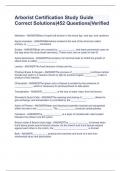Arborist Certification Study Guide
Correct Solutions|452 Questions|Verified
Meristem - ANSWERSites of rapid cell division in the shoot tips, root tips, and cambium.
Apical meristem - ANSWERMeristems located at the end of the shoot are called
primary, or _________ meristems
Scales - ANSWERBuds are covered by _____________ that leave permanent scars on
the twig when the buds break dormancy. These scars can be useful in tree ID.
Apical dominance - ANSWERThe tendency for terminal buds to inhibit the growth of
lateral buds is called ______________.
Leaves - ANSWERThe food factories of trees are the ____________.
Photosynthesis & Oxygen - ANSWERThe process of _____________ combines carbon
dioxide and water in a reaction driven by light to produce sugars. _________ is also a
product of this reaction.
Chlorophyll - ANSWERThe green color of leaves is created by the presence of
_____________, which is necessary for photosynthesis to take place.
Transpiration - ANSWER___________ is the loss of water vapor from the leaves.
Stomata & Guard Cells - ANSWERThe opening and closing of _________ allows for
gas exchange, and transpiration is controlled by the ___________.
Xylem & Phloem - ANSWERWater and dissolved essential minerals are transported
within the tree in the ___________. The ____________ conducts carbohydrates.
Cambium - ANSWERThe ______________ is a layer of meristematic cells located
between the phloem and the xylem.
Branch collar & Branch bark ridge - ANSWERThe ______ ________ is formed when
trunk tissue grows around branch tissues. As the branch and trunk tissues expand
against each other in the crotch, the __________ ______ ________ is formed.
Bark - ANSWER___________ protects the branches and trunk of a tree from
mechanical injury and desiccation.
,Absorption, conduction, anchorage, and storage. - ANSWERName four functions of the
root system>
Osmosis - ANSWERWater enters young roots or mycorrhizal roots by a process called
______________.
Tropism, Phototropism & Geotropism - ANSWERThe orientation of growth in response
to an external stimulus is called _____________. Two examples are ___________ and
____________.
CODIT - ANSWERCompartmentalization Of Decay In Trees
Excurrent & Decurrent - ANSWERTrees with upright growth and a strong, central leader
are said to exhibit ______________ growth. More rounded trees, which are often
broader than they are tall, have ______________ growth habits.
Mycorrhizae - ANSWERRoots and fungi called ___________ exist in a symbiotic
relationship, which aids in the uptake of water and minerals.
Respiration - ANSWERThe process by which chemical energy, stored as sugar and
starch, is released is called ______________.
Deciduous & Evergreen - ANSWERTrees that lose their leaves in the fall are called
_________. Trees that maintain their leaves for more than one year are called
___________.
Twig anatomy - ANSWERtwig anatomy
Cross section of young stem - ANSWERStem anatomy
Auxin - ANSWERA plant hormone
Cuticle - ANSWERWaxy covering of a leaf
Petiole - ANSWERStalk of a leaf
Internode - ANSWERBetween the nodes of a twig.
Lenticel - ANSWERSmall openings in stems for gas exchange.
Ray - ANSWERCells that cross the phloem and xylem for radial transport.
Absorbing roots - ANSWERmostly located in the upper 12 inches of soil.
Source - ANSWERMature, green leaves -- sugar producers.
,Sink - ANSWERUses more energy than it produces.
Taxonomy - ANSWERThe classification of plants is called __________.
Kingdom
Phylum
Class
Order
Family
Genus
Species epithet - ANSWERList the levels of plant classification. The first letter of each
term is given.
Angiosperms and Gymnosperms - ANSWER___________ are vascular plants whose
seeds are covered (by an ovary). __________ are vascular plants with "naked seeds".
Monocotyledons (or monocots) - ANSWERThe term "dicotyledon (dicot)" refers to
plants that have two seed leaves at germination. Grasses and palm trees belong to
another group called _________ and have only one seed leaf.
Nomenclature - ANSWERThe naming of plants is called ___________.
Form or growth habit
Bark texture
Leaves
Flowers
Fruit
Seed
Buds
Leaf scars
Scent - ANSWERName five plant characteristics used to identify trees.
Opposite leaves - ANSWERIn temperate zones, most of the trees with opposite leaf
arrangement fall into four genera represented by "MAD Buck", for Maple, Ash,
Dogwood, and Buckeye.
Alternate leaves - ANSWERAlternate leaves
Whorled leaves - ANSWERWhorled leaves
buckeye, horsechestnut (pictured) - ANSWERName a tree with palmately compound
leaves __________.
Ash, walnut, Kentucky coffeetree, ailanthus, honeylocust - ANSWERName a tree with
pinnately compound leaves __________.
, Lobed leaf - ANSWER
Compound leaf with serrate margins - ANSWER
One - ANSWERA compound leaf with multiple leaflets will have _________ bud(s).
ponderosa pine - ANSWERGive an example of a tree that has more than one common
name: _____________.
Genus and Specific Epithet - ANSWERIn the scientific name Acer saccharum, Acer
identifies the ___________, and saccharum identifies the _________ ____________.
Varieties and cultivars - ANSWERSpecies are often subdivided into _________ or
___________ that have distinct differences from the general species.
Cultivar - ANSWERA ___________ is a cultivated variety.
There are not in the same genus. - ANSWERDouglas fir (Pseudotsuga menziesii)
differs from blasam fir (Abies balsamea) in that...
Opposite - ANSWERWhen two leaves and/or buds are located at the same node on a
twig, the arrangement is called...
Quercus rubra - ANSWERSelect the scientific name that is written correctly...
Quercus (oaks) - ANSWERWhich genus of trees usually does NOT have an opposite
leaf arrangement?
Pines - ANSWERWhich conifers have needles in bundles?
45%, 50%, and 5% - ANSWERBy volume, ideal soils are composed of ____ percent
mineral materials (sand, silt, and clay), ____ percent open or pore space, and ____
percent organic matter and organisms.
O: Organic Layer
A: Contains most of the Absorbing roots of trees
E: Mineral Weathering
B: Composed of fine-textured materials from the A horizon and soil particles from the
lower parent material.
C: subsoil, the lowest layer other than bedrock, composed of rocky parent material. -
ANSWERWhat are the 5 major soil horizons?
O, A, E, B, and C - ANSWERSoil horizons
O and A soil horizon - ANSWERThe majority of the fine, absorbing roots of a tree are in
the _____ and ____ horizons.




